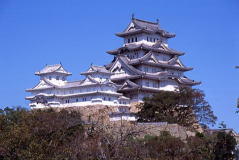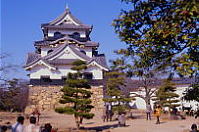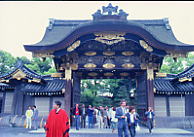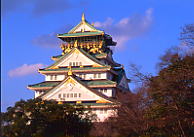 |
|
|
Himeji Castle |
|
 g @@ @¨ @@@@@@@@ |
|
| Himeji Castle, in which the military and the aesthetic achieved their most
perfect expression, was designated in December 1993, along with the Horyuji
Temple, a World Heritage Site, the first time any Japanese cultural property
had been so honored. The glorious shape of the castle is compared with an egret soaring into the sky.So the castle is also called Hakuro-jo, meaning White Egret Castle. Himeji is 37 minutes west of Kobe, 60 minutes west of Osaka by JR.. |
|
|
|
|
 Hikone city Website ¨ |
|
|
Built on top of Mount Hikone, a hill 163 meters above sea level surrounded
by a plain, |
|
Nijo Castle (World Heritage Site) |
|
 Kyoto city Website@¨ |
|
| Nijo Castle was begun by Tokugawa Ieyasu, the Shogun, in 1603 to protect the Imperial Palace and to provide him with a residence when he visited Kyoto. It was completed in 1626 by the third Tokugawa Shogun, Iemitsu, who moved what was left of Fushimi Castle to Nijo. A blend of buildings left by Toyotomi Hideyoshi during the Bunroku era, structures built by Ieyasu during the Keicho era and paintings and sculptures commissioned by Iemitsu, Nijo Castle provides an overview of the style of the Momoyama Period. | |
| Osaka Castle | |
 Osaka city Website@¨ |
|
|
In 1583, Toyotomi Hideyoshi built Osaka Castle on the ruins of the Ishiyama Honganji Temple, intending to make it even more magnificent than Azuchi, the splendid castle upon which Osaka Castle was modeled. During the Tokugawa period, Osaka Castle had no keep and when the Shogunate collapsed the castle too disappeared. The present-day keep was rebuilt using contemporary construction methods in 1928 with the help of donations from the people of Osaka, who wanted to restore their cityfs symbol. |
|
| Maruoka Castle | |
|
Another ghill-on-the-plainh castle, like Hikone, Maruoka Castle was built in 1576 by Shibata Katsutoyo, the nephew and adopted son of Shibata Katsuie. It boasts the oldest remaining castle keep of any castle in Japan today. In 1934 Maruoka Castle was named a national treasure, but it was destroyed in the Great Fukui Earthquake of 1948. After being named an important cultural property in 1950, it was rebuilt in 1955. |
|
